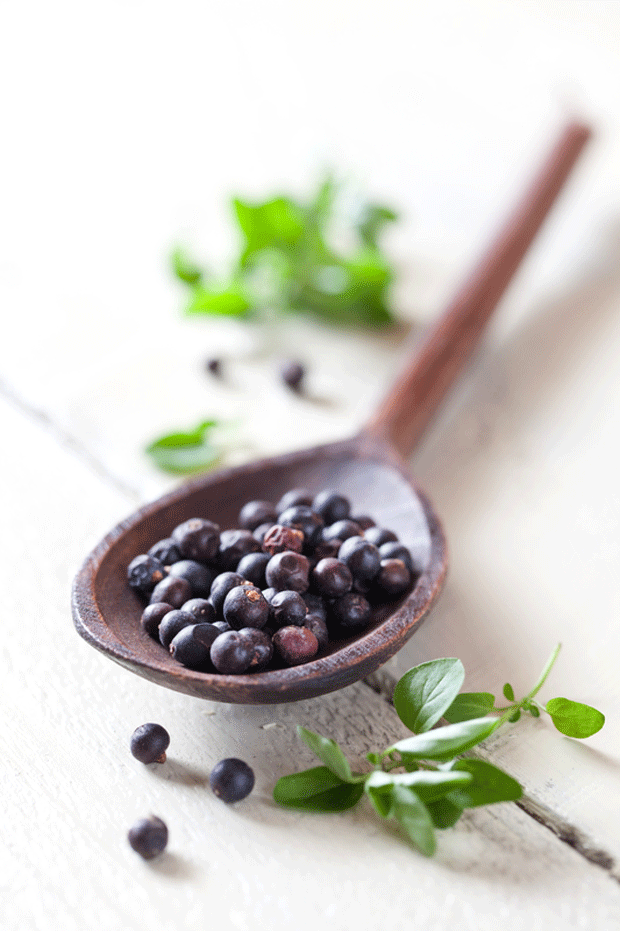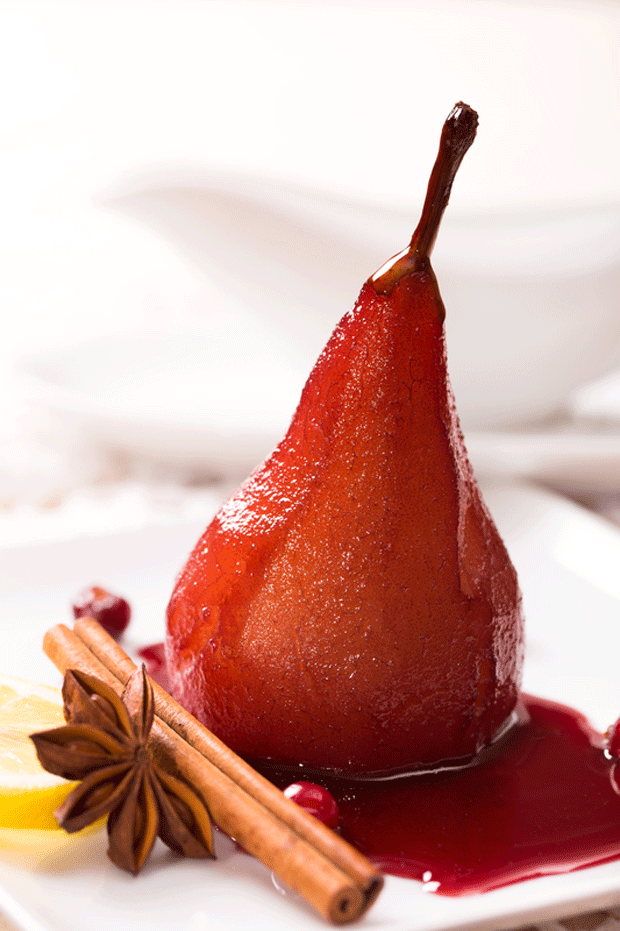Can you grow juniper berries in New Zealand?

Juniper berries aren’t typically found in your average kitchen, but this exotic fruit offers a flavour that jumps out at you and can add that extra punch needed to spice up a dish.
Words: Jenny Somervell
Bright, fresh, piney, pungent, resinous and slightly spicy. Think ‘gin’ and you’re getting close. Juniper (Juniperus communis) is uncommon and slightly exotic, and not usually found on the average kitchen herb rack.
It’s more likely to be spotted on the menu of an upmarket restaurant as the ‘wow’ factor, paired with duck or pork. Some cooks suggest it as a substitute where you would use rosemary, and indeed it does complement the same robust flavours that rosemary works with: wild game, pork, beef, lamb, stronger flavoured vegetables, and dishes containing black pepper, tomatoes, garlic, sage and onions.
Juniper berries looked like something we could use. In fact I was surprised we’d never tried them and it was clearly time we did so I headed off to the Mediterranean food shop to find some. Mission accomplished, the chef wasted no time grinding them up, sniffing and tasting them. The aroma was musky and piney, reminiscent of fresh Christmas wreaths.
“Wait a minute!” I said before we took a bite, recalling warnings about renal toxicity. “They might be poisonous!” My husband just rolled his eyes at me and took another bite, and he’s in good company. In the 1800s and 1900s American folk medicine practitioners suggested chewing juniper berries for indigestion and to stimulate appetite (not that my husband needs the latter!).
Juniper in the past, like many herbs, the medicinal uses of juniper were better known in the past than the present. It was and still is recognised for its warming, stimulating and disinfecting properties. The ancient Greeks and Romans took juniper to ease the aches and pains of rheumatism, North American Indians made tonics of juniper to treat kidney problems, urinary tract infections, muscle and joint pain, stomach upset, ulcers, wounds, colds, flus, high fevers and respiratory infections. In medieval times juniper was a favourite herb for scattering on floors to freshen, cleanse and purify the environment from infection and disease.
According to legend, burning the wood banished evil spirits and warded off plague. Planting a juniper bush by one’s front door was believed to keep witches away as supposedly the only way for a witch to get past the plant was by correctly counting its needles! “Pure superstition,” we might say today, but juniper extract has been shown to be an effective antiseptic, with up to two-thirds more inhibitory effect than penicillin. Juniper wood has a remarkable ability to resist decay and insects, even when exposed to the soil, so if you cut any trees down you might consider stump-munching.
Today’s herbalists use juniper to treat urinary tract infections (but not kidney infection), and internally and externally for swelling, rheumatoid arthritis, and other joint pain, muscle pain and tendonitis. The essential oil has been used topically to treat respiratory infections, congestion, coughs, and chronic skin conditions such as psoriasis. The antiseptic effect of juniper is contained in the 1% essential oil extracted from the ripe berries. The oil also contains pinene (the piney smell of pine trees) which is a mild stimulant and expectorant.
But the warnings of renal toxicity have some merit. All parts of the tree, but especially the fresh berries, contain the terpene alcohols, in particular terpin-4-ol, a known diuretic that can cause irritation to kidney function. These oils deteriorate when berries are dried and cured, so professional advice is advised when using strong extracts of juniper for therapeutic use.

WHICH JUNIPER IS THE RIGHT ONE?
The juniper genus contains 50 species, most of them aromatic woody plants producing oil. Juniperus communis, an evergreen conifer related to cedar and cypress, is the most widespread. Plants are found in the cooler regions of the northern hemisphere in hilly to alpine regions up to 3000m. A circumnavigation of the globe finds them through the northern US, Canada, Greenland, Iceland, northern Europe through northern Asia and south to Japan.
Juniper prefers well-drained, slightly acidic, gravelly or rocky soil. It doesn’t tolerate shade, preferring an open environment, and does well in harsh, stressed sites provided there is no competition, although it does too well in some places – in parts of North America it has reached weed status. One thing that confused me about Juniper communis was the different descriptions found in books for the same plant.
It turns out that common juniper (J. communis) can range in form from a low shrub to a small tree up to 10m (30ft) in Europe. Five distinct varieties have been identified and there are a huge range of ornamental cultivars highly valued as ground cover plants in sunny, exposed spots including J. communis Compressa, Depressa Aurea, Hibernica, Repanda, Effusa and Dumosa.
CAN YOU GROW JUNIPER IN NZ?
Many years ago I grew a Juniperus communis plant from seed, a laborious process requiring both treatment for its hard seed coat and cold stratification, and I wouldn’t recommend it – cuttings are much easier. I had read about the berries so I watched my plants closely each year expecting fruit. Three years then four years passed, the plants grew painfully slowly, and still the berries never came.
It turned out that the plants are dioecious, a vital piece of information not mentioned in my books. This means that male and female flowers are borne on different plants and both are required for pollination and therefore, seeds. Pollen is carried by the wind to the receptive female flowers on female plants and hey presto, seeds are born.
This little quirk of nature no doubt has some evolutionary advantage, but for the home grower it’s bit of a nuisance. The chances of scoring male and female plants aren’t great but if you do, ‘berries’ will develop on female plants only. Technically they are not berries at all, but seed cones. The cones are globular and resinous, and can be found in various stages of ripeness on the same plant. They take 2-3 years to ripen, starting off green and slowly ripening to silvery-bluish black, somewhat resembling blueberries.
Much of the world’s supply of juniper berries are grown in eastern Europe where they are harvested in autumn and dried in the shade to avoid losing the oil. However, if you are thinking about growing your own, you may struggle to find male and female plants and some suggest the flavour may be disappointing. (I never managed to grow any so cannot verify!). The best berries come from Macedonia and Albania. Failing the ‘grow your own’ option, berries can be tracked down in specialist food shops and are worth experimenting with. If you are a fan of a good gin and tonic then the flavour is likely to appeal.
PRECAUTIONS
• Juniper oil or extracts should not be used by anyone with a kidney infection or kidney disease.
• Avoid during pregnancy.
• Do not apply the oil undiluted to skin.
• Advice from a registered health care professional is recommended for therapeutic use.
TIPS FOR USING JUNIPER
1. For best flavour, buy whole berries and grind for use.
2. Buy in small quantities as the flavour diminishes with long storage.
3. Use freshly ground berries only.
4. Complements strong flavours, eg game, pork and beef.
5. Use to punch up sauces and soups or add heart to tomato sauce.
6. Goes well with red or black pepper, sage, parsley, garlic, mint or onions.
7. Use with a dash of vinegar in marinades to bring out the berries’ citrus flavours.
8. Rub into meat with ginger or garlic.
Poached Pears and Juniper

INGREDIENTS
4 firm pears
6-8 dried juniper berries
1 tbsp brown sugar
½ cup red wine (merlot, cab sav or similar)
½ cup orange juice
extra wine & orange juice if required
METHOD
Peel and core the pears, cut in half and lay flat side down in a pot or oven-proof dish just large enough to hold them. Crush the juniper berries and combine with the brown sugar, wine and orange juice and pour over the pears. Add more wine and orange juice as required to cover the pears. Heat gently until just simmering, spooning the liquid over the pears if required, but it works best if the pears are covered by the liquid. Simmer gently until the pears soften, about 45 minutes depending on the firmness of the pears.
Love this story? Subscribe now!
 This article first appeared in NZ Lifestyle Block Magazine.
This article first appeared in NZ Lifestyle Block Magazine.
